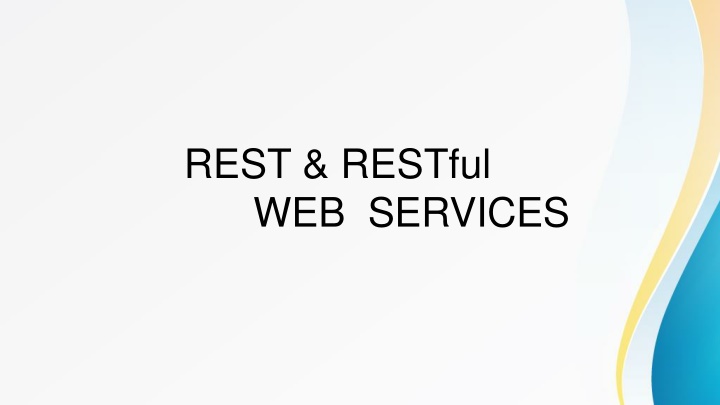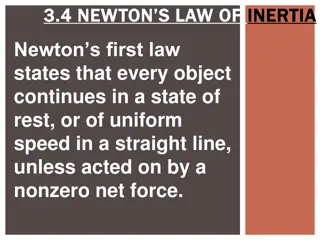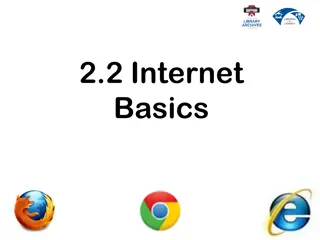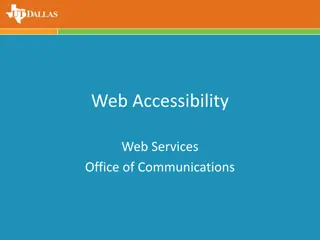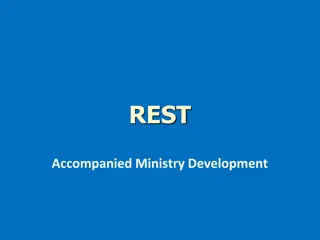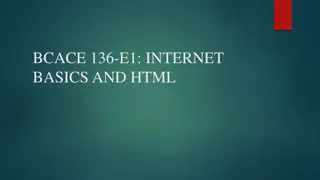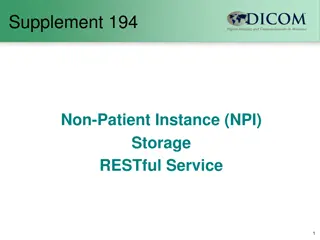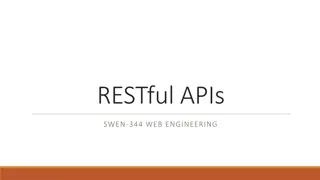REST and RESTful Web Services
REST, which stands for Representational State Transfer, is an architectural style for designing networked applications. It revolves around the concept of resources and how to represent and manipulate them in various ways. REST emphasizes a client-server communication model and offers a simple, interoperable, and flexible approach to developing web services. It is not a protocol, standard, or a replacement for SOAP. The architecture of the Web today is largely based on REST principles, making it a widely used software architectural model for distributed systems like the World Wide Web.
Download Presentation

Please find below an Image/Link to download the presentation.
The content on the website is provided AS IS for your information and personal use only. It may not be sold, licensed, or shared on other websites without obtaining consent from the author.If you encounter any issues during the download, it is possible that the publisher has removed the file from their server.
You are allowed to download the files provided on this website for personal or commercial use, subject to the condition that they are used lawfully. All files are the property of their respective owners.
The content on the website is provided AS IS for your information and personal use only. It may not be sold, licensed, or shared on other websites without obtaining consent from the author.
E N D
Presentation Transcript
REST & RESTful WEB SERVICES
In a Nutshell REST is about resources and how to represent resources in different ways. REST is about client-server communication. REST is about how to manipulate resources. REST offers a simple, interoperable and flexible way of writing web services that can be very different from other techniques.
REST is NOT! A protocol. A standard. A replacement for SOAP .
REST Representational State Transfer Architectural style (technically not a standard) Idea: a network of web pages where the client progresses through an application by selecting links When client traverses link, accesses new resource (i.e., transfers state) Uses existing standards, e.g., HTTP REST is an architecture all about the Client-Server communication.
An Architectural Style REST is the architecture of the Web as it works today and, so it is already used in the web! It is an software architectural model which is used to describe distributed systems like WWW (World Wide Web). It has been developed in parallel with HTTP protocol.
REST Client requests a specific resource from the server. The server responds to that request by delivering the requested resource. Server does not have any information about any client. So, there is no difference between the two requests of the same client. A model which the representations of the resources are transferred between the client and the server. The Web as we know is already in this form!
Resources Resources are just consistent mappings from an identifier [such as a URL path] to some set of views on server-side state. Every resource must be uniquely addressable via a URI. If one view doesn t suit your needs, then feel free to create a different resource that provides a better view. These views need not have anything to do with how the information is stored on the server They just need to be understandable (and actionable) by the recipient. Roy T . Fielding
Requests & Responses REQUEST GET /news/ HTTP/1.1 Host: example.org Accept-Encoding: compress, gzip User-Agent: Python-httplib2 Here is a GET request to http://example.org/news/ Method = GET
Requests & Responses And here is the response RESPONSE HTTP/1.1 200 Ok Date: Thu, 07 Aug 2008 15:06:24 GMT Server: Apache ETag: "85a1b765e8c01dbf872651d7a5" Content-Type: text/html Cache-Control: max-age=3600 <!DOCTYPE HTML> ...
Requests & Responses The request is to a resource identified by a URI (URI = Unified Resource Identifier). In this case, the resource is http://example.org/news/ Resources, or addressability is very important. Every resource is URL-addressable. To change system state, simply change a resource.
URI Examples http://localhost:9999/restapi/books GET get all books POST add a new book http://localhost:9999/restapi/books/{id} GET get the book whose id is provided POST update the book whose id is provided DELETE delete the book whose id is provided
REST Characteristics Resources: Application state and functionality are abstracted into resources. URI: Every resource is uniquely addressable using URIs. Uniform Interface: All resources share a uniform interface for the transfer of state between client and resource, consisting of Methods: Use only HTTP methods such as GET, PUT, POST, DELETE, HEAD Representation Protocol (The constraints and the principles) Client-Server Stateless Cacheable Layered
HTTP Methods GET safe, idempotent, cacheable PUT - idempotent POST DELETE - idempotent HEAD OPTIONS
CRUD Operations Mapped to HTTP Methods in RESTful Web Services OPERATION HTTP METHOD Create POST Read GET Update PUT or POST Delete DELETE
RESTful Web Services RESTful web services are web services which are REST based. Stateless & cacheable. Uses URI & HTTP methods. Frequently used with SOA projects. Quiet light, extensible and simple services. The reason behind the popularity of REST is that the applications we use are browser-based nowadays and top it all, REST is built on HTTP. Main idea: Providing the communication between client and server over HTTP protocol rather than other complex architectures like SOAP and RPC etc.
RESTful Web Services You can do anything you already do with normal web services. No severe restrictions on how the architectural model will be and what properties it will have. Models like SOAP have severe rules, REST does not. There are lots of frameworks to develop RESTful web services on platforms like C# and Java, but you can write one easily using some standard libraries. Inspite of the low bandwidth, large data have been transfered with methods even inflating the size of the data, like XML with SOAP . Why? Nowadays, the bandwidth is amazingly large, but we still use JSON and it shrinks the size of our data.
RESTful Web Services Platform independent. Language independent. Work on HTTP protocol. Flexible and easily extendible. They also have some constraints or principles. Client-Server Stateless Cacheable Uniform Interface Layered System Code on Demand
Client-Server Seperation of concerns. Client and server are independent from eachother. Client doesn t know anything about the resource which is kept in the server. Server responds as long as the right requests come in. Goal: Platform independency and to improve scalability.
Stateless Each request is independent from other requests. No client session data or any context stored on the server. Every request from client stores the required information, so that the server can respond. If there are needs for session-specific data, it should be held and maintained by the client and transferred to the server with each request as needed. A service layer which doesn t have to maintain client sessions is much easier to scale. Of course there may be cumbersome situations: Scalability The client must load the required information to every request. And this increases the network traffic. Server might be loaded with heavy work of validation of requests.
Cacheable HTTP responses must be cacheable by the clients. Important for performance. If a new request for the resources comes within a while, then the cached response will be returned.
Uniform Interface All resources are accessed with a generic interface (HTTP-based). This makes it easier to manage the communication. By the help of a uniform interface, client and server evolve independently from eachother. E.g. LEGO; eventhough there are different shaped pieces, there are only a few ways to pair up these pieces.
Layered System There can be many intermediaries between you and the server you are connecting to. Actually, a client does not know if it is connected to the last server or an intermediary server. Intermediaries may improve performance by caching and message passing. Intermediary servers can increase scalability by load-balancing and can force clients to form some sort of security policies. This structure can be used when encapsulation is needed.
Code on Demand Servers can send some kind of executable scripts to the client-side in order to increase or change the functionality on the client side. This may cause low visibility, so it is the only optional constraint. EXAMPLE ... <head> <script src="utility.js" type="text/javascript"> </script> ...
more If a service does not include all constraints out of Code on Demand , it is not a RESTful web service. The most epic constraint is Stateless .
What REST actually aims for? Scalability Simplicity Modifiability Useability Portability Reliability
Benefits Other Benefits Simplicity Evolvability Reuseability Visibility Extensibility Configuration Customizability Network Performance Efficie ncy Scalability User Perceived Performance
Benefits ctd. HTTP is efficient because of all those caches, your request may not have to reach all the way back to the origin server. Scalability comes from many areas. The use of layers allows you to distribute traffic among a large set of origin servers based on method, URI or content-type, or any other visible control data or meta-data in the request headers. Caching also helps scalability as it reduces the actual number of requests that hit the origin server. Statelessness allows requests to be routed through different gateways and proxies, thus avoiding introducing bottlenecks, allowing more intermediaries to be added as needed. [Scalability]
Will REST Replace Other Technologies ? There is actually an untold story that both technologies can be mixed and matched. REST is very easy to understand and is extremely approachable, but does lack standards and is considered an architectural approach. In comparison, SOAP is an industry standard with a well-defined protocol and a set of well-established rules to be implemented, and it has been used in systems both big and small.
REST vs SOAP SOAP is a XML-based message protocol, while REST is an architectural style. SOAP uses WSDL for communication between consumer and provider, whereas REST just uses XML or JSON to send and receive data. SOAP invokes services by calling RPC method, REST just simply calls services via URL path. SOAP doesn't return human readable result, whilst REST result is readable with is just plain XML or JSON. SOAP is not just over HTTP , it also uses other protocols such as SMTP , FTP , etc, REST is over only HTTP .
So the areas that REST works really well are: Limited bandwidth and resources; remember the return structure is really in any format (developer defined). Plus, any browser can be used because the REST approach uses the standard GET, PUT, POST, and DELETE verbs. Again, remember that REST can also use the XMLHttpRequest object that most modern browsers support today, which adds an extra bonus of AJAX. Totally stateless operations; if an operation needs to be continued, then REST is not the best approach and SOAP may fit it better. However, if you need stateless CRUD (Create, Read, Update, and Delete) operations, then REST is it. Caching situations; if the information can be cached because of the totally stateless operation of the REST approach, this is perfect.
THANK YOU FOR YOUR PATIENCE AND LISTENING!
